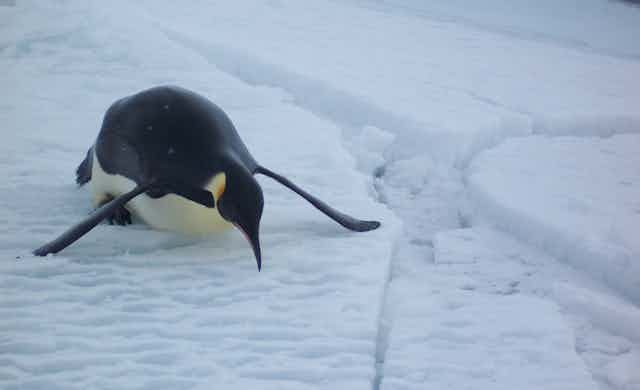Emperor penguins have been spotted breeding on ice shelves for the first time, where previously they were thought only to breed on the much lower ice that floats on the ocean surface.
It is not clear whether they are climbing onto the shelf ice because of a lack of their preferred sea ice, and whether the behaviour will ultimately offer them a safe haven from climate change.
Satellite and aerial images have revealed four colonies of the birds breeding on ice shelves - which are formed by glaciers that flow over land towards the coast - at a range of Antarctic locations.
A study, published last week in the journal PLOS ONE, showed that two of the colonies have only been seen on shelf ice, whereas the other two moved between sea and shelf ice from year to year.
The discovery is a surprise because emperor penguins - which are up to 1.15 metres tall and can weigh 40 kilograms - were thought to be too clumsy to climb onto ice shelves, which can tower up to 30m above the sea ice below.

Barbara Wienecke of the Australian Antarctic Division said the penguins mainly climbed onto ice shelves in areas where they sloped more gently, as a result of snowfall or weathering of old ice faces.
“Rather than having a steep, clean-cut cliff you have sometimes a rather gently sloping hill. They are certainly not able to climb up a 30m sheer cliff,” she said.
The behaviour was first spotted in 2009, and it is not clear whether it is genuinely new or has just never been noticed until now.
But the observations made so far suggest that the two colonies that switched between sea ice and shelf ice did so in breeding years when the sea ice formed late.
Emperor penguins breed during the Antarctic winter and their chicks fledge the following summer. That means that from April to December they need smooth, flat ice that is anchored to the shore (to prevent floating away), with ready access to open water for catching fish. Males also need to eat snow to stay hydrated during the long months incubating their young.
“If the sea ice is insufficient to maintain the colony they have two choices: either they find an alternative or they just don’t breed at all,” Wienecke said.
It is possible, however, that the penguins could find themselves stranded if the gently sloping section breaks away to form an iceberg - leaving them literally high and dry with no food or water.
The emperor penguin is listed as near threatened, and some estimates predict its numbers will halve by the middle of this century as the sea ice recedes.
It far from clear whether the penguins can take refuge on ice shelves as climate change takes hold, or whether they will have to retreat to higher-latitude coastlines such as the Ross Sea.
The newly observed colonies are modest in size, with between 3000 and 3800 adults. But the largest traditional colonies can number up to 40,000 adult penguins.
“I am really not quite sure what is going to happen to them, but I dare say that it is a species that is still very much under strife,” Wienecke said.
Graham Robertson, also of the Australian Antarctic Division, said it would be a long time before emperor penguins run out of sea ice.
“There are fairly dire predictions for the decline of the sea ice environment over this current century, but we’re not seeing a change in the sea ice now to the extent where emperor penguins are running out of space to stand and breed,” he said.
An ability to climb onto shelf ice is more likely to be positive than negative for the penguins’ long-term prospects - as long as they can find a location that still allows them to breed, huddle and fish without suffering conditions that are too harsh, he said.
But Dr Robertson described the shelf ice as an “unreliable backstop”, and said the penguins will need to be watched closely to see how they fare in the future.
“We can’t sigh with relief and say ‘thank god for that, they’re going to be right’ through a century in the face of global warming,” he said.


